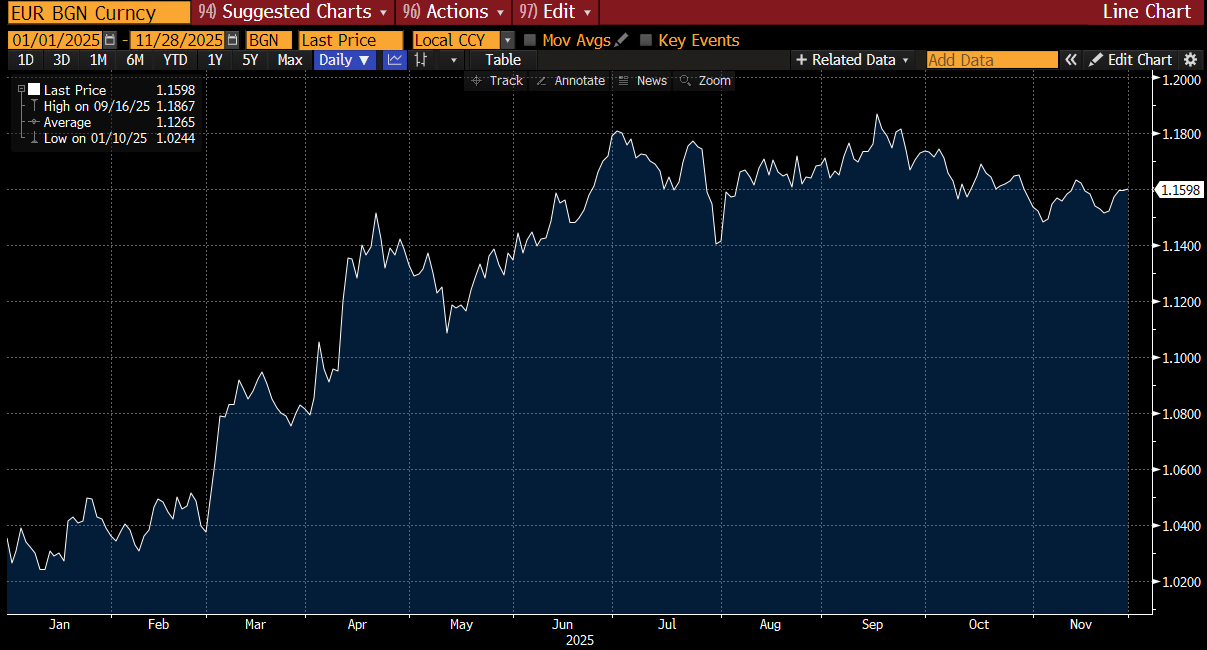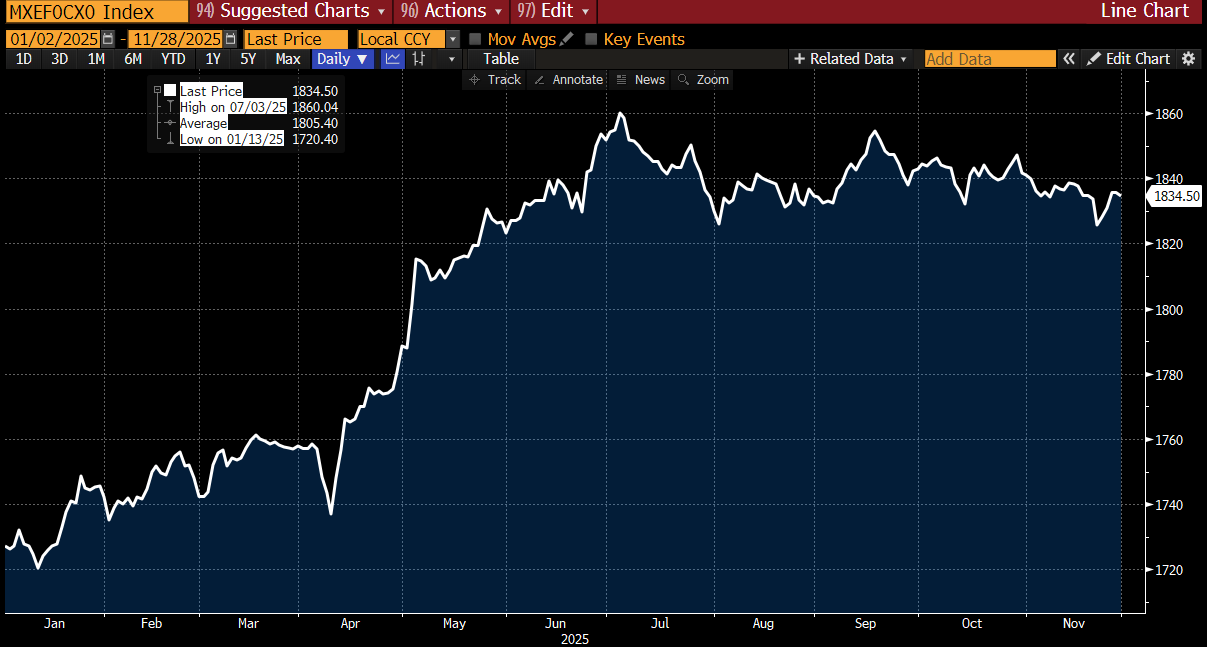Monthly Currency Outlook
December 2025 Currency outlook
What Happened
- After trading within a 1.0%-range throughout the month, the U.S. Dollar fell by 0.3% in overall value in November with mixed movements across the board
- Lack of access to official data in the midst of a government shutdown resulted in confusion, mixed guidance, and stagnant markets
- Following positive growth indicators for the Euro-zone, the €uro closed out the month with a 0.6% gain
- The Mexican Peso was amongst the best Majors performers, up by 1.0%, despite interest rates being decreased as Q3 Gross Domestic Product contracted
- Tensions between China and Japan over diplomatic positions helped bring 1.3% JPY depreciation, dropping Yen to its weakest point since January
Monex USA’s View
- While it may be guaranteed that the Fed cuts by 25 basis points, the Dollar’s weakening may not be as Fed members lack consensus over future policy
- Plenty of data looking back as far as September may overwhelm decisionmakers and delay any conclusions about the state of the economy
- Refusal to lower borrowing costs by the European Central Bank and potential peace deal between Ukraine and Russia may bode well for Euro value
- GBP strength could be at risk if the Bank of England cuts interest rates for the first time since August
- Mexican Peso resilience faces one last challenge after jumping 12.5% thus far in 2025
IN FOCUS
EUR: Although it has dropped 2.3% since mid-September, € is up 13.0% for the year, for now

(Bloomberg chart shows the Euro’s successful run throughout the first three quarters of the year)
Euro-zone problems have not stopped the shared currency from climbing to its best since 2021
- While countries vary in their performance, the Euro-zone managed to avoid contractionary growth with annual Q3 Gross Domestic Product averaging 1.4%
- Although consumers kept experiencing higher prices with Consumer Price Index yearly at 2.1%, suppliers have seen prices go down with PPI at (-0.2%)
- European Central Bank officials have not reduced interest rates since June and current odds that they act loosely on December 18th stand at 2.2%
- Regardless of a political crisis in France, discord in Spain, and “stagflation” in Germany, Euro is steady
THE VIEW — Is another “hawkish” cut in the works for the Fed’s final act?
U.S. Dollar strengthening may not be off the table with global stagnation
A year that has been beyond just eventful is coming to an end. However, the endgame and what is brewing ahead may not be easy to digest. The longest U.S. government shutdown in history got in the way of being able to look at all that has occurred and accurately assess what the true economic picture comes close to for the last third of 2025. Sentiment across market classes seems to be dragging as everyone is questioning the sustainability of the tech sector’s fast growth. Meanwhile, the U.S. Dollar’s deterioration has hit the brakes after a rough start in what marked the worst six-month run ever with only July and October representing gains towards recovery.

(Bloomberg chart shows the MSCI Emerging-Markets Currency Index up by 6.2% thus far in 2025)
It has been a frustrating time for statisticians and those depending on their work ever since the government shutdown began on October 1st. Beginning a new quarter and having no eyes on data for September was not ideal, but lacking any clue for seven weeks has been unprecedented. Private gauges helped in confirming that the U.S. labor sector is going through some constraints, but no releases for inflation or Gross Domestic Product offer little clarity about what exactly is going on and how to appropriately address it by financial policymakers.
Fed officials have stated as much and during the first half of November the absence of visibility put the likelihood of cutting interest rates at risk with odds of a 25-basis-point reduction for the December 10th FOMC meeting plummeting to as low as 29.3% by November 19. Responsibly, voting members would not be comfortable executing any type of decision without some ability to examine collected figures.
Nevertheless, this rapidly changed after some statements from Fed members explaining comfort with alleviating the financial system, in particular, New York Fed President John Williams that counter hesitation shown by Chairman Jerome Powell. This may be due to recent evidence of “stagflation,” low levels of growth combined with stubborn inflationary pressures.
On November 25th, available numbers for Producers Price Index from September revealed the annual average climbed from 2.6% to 2.7%. At the end of October, Powell warned that a cut in December was not “automatic” for him, citing concern with prices remaining elevated. On the other hand, those on the slash camp can argue that it is time to seriously address threats to growth with U.S. factory activity shrunk to its worst in four months as orders have taken a hit.
As surprising as it may seem, exercising looser monetary policy may not always cause a currency to face losses. For example, the U.S. Dollar has been climbing from the moment the Federal Reserve finally decided to start an expansionary cycle with a cut back in mid-September. The Buck is up 2.4% since September 16th according to the Bloomberg Dollar Spot Index. If markets perceive the interest rate discount as accommodative to a financial environment in an economy that is still registering positive GDP growth, this might once again give rise to the USD when other global economies are compared.
Elsewhere, the narrative is not that uplifting, with China coping with deflationary worries and anemic levels of activity with trade always in turmoil. The latest Chinese reading of Purchasing Managers Index revealed a result below 50.0, which marks expansion, for the eighth consecutive month. On the other side of the pond, the Euro-zone has been saved by expansion in France notwithstanding parliamentary friction over an acceptable budget with unpopular tax hikes.
Over in the U.K. Pound Sterling will be tested after jumping by 0.7% with the upcoming Bank of England meeting on December 18th likely resulting in an interest-rate cut with current chances standing at 92.3%. That date will be a busy one for central bank action as the ECB as well as Mexico’s Banxico also gather and hold press briefings.
The next day, it will be followed by the crucial BOJ decision announcement. Emerging-Markets and LATAM FX flows will surely be significant after some reversals in tariffs from the U.S. On November 14, the White House reversed tariffs to coffee, exotic fruits, concentrated juices, and other food items in an attempt to bring down prices of groceries for American consumers. All this and possibly a ceasefire between Russia and Ukraine will make for plenty to chew on as 2025 reaches the finish line.
Ready to optimize your FX with our award-winning trading team?
BOOK AN INTRO MEETING OPEN A FREE ACCOUNT

